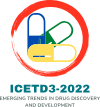Speaker
Description
Excessive exposure to UV rays causes hyperpigmentation, premature aging, and skin cancer. Due to these harmful effects of UV radiation, there is a need to develop sunscreen formulations to heal and prevent sunburn and increase the level of protection from the UV rays. Flavonoids and phenolic compounds have a good capacity to absorb UV rays in UV-A region and possess good antioxidant activity. Aim of the study conducted was to develop herbal formulation for photoprotective activity. Liquorice root and pomegranate peel were selected for the study because they contain phenolics and flavonoids in abundance. Both methanolic extract and hydroalcoholic extract of individual herbal drugs were prepared. Total phenolic content of all extracts was determined by the Folin Ciocalteau method. The total flavonoid content of all extracts was measured by AlCl$_{3}$ method. The antioxidant activity of all extracts was evaluated by DPPH assay method. The SPF (Sun Protection Factor) value of combined methanolic extract and combined ethanolic extract of both herbal drugs were determined by Mansur equation. Four cream formulations were prepared using different percentages of combined methanolic extracts and SPF value was evaluated. The physical parameters like appearance, spreadability, pH, and viscosity of all four cream formulations were also evaluated. Total phenolic content was found higher in the hydroalcoholic extract of pomegranate peel and total flavonoid content was found higher in methanolic extract of liquorice. IC$_{50}$ value of pomegranate peel methanolic extract was 64.5 µg/mL, and it showed good anti-oxidant potential. IC$_{50}$ value of liquorice hydroalcoholic extract was 53.7 µg/mL, so hydroalcoholic extract showed good antioxidant potential. Methanolic extract of both herbal drugs showed good photoprotective activity as compared to combined hydroalcoholic extract so methanolic extracts were selected for incorporation in the herbal cream formulation. It was observed that by increasing the concentration of extract from 2% to 8%, the SPF value of cream formulation increased. The herbal cream formulation containing 8% of combined methanolic extract of both liquorice root and pomegranate peel showed good physical characteristics and optimum photoprotective activity. So it can be concluded that liquorice root and pomegranate peel have good potential as sunscreen agents and they can be explored further to develop a safe and effective herbal cosmetic product for photoprotective activity.
